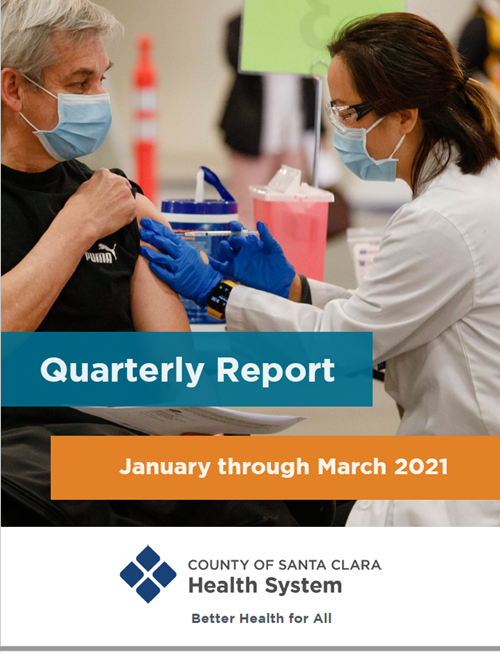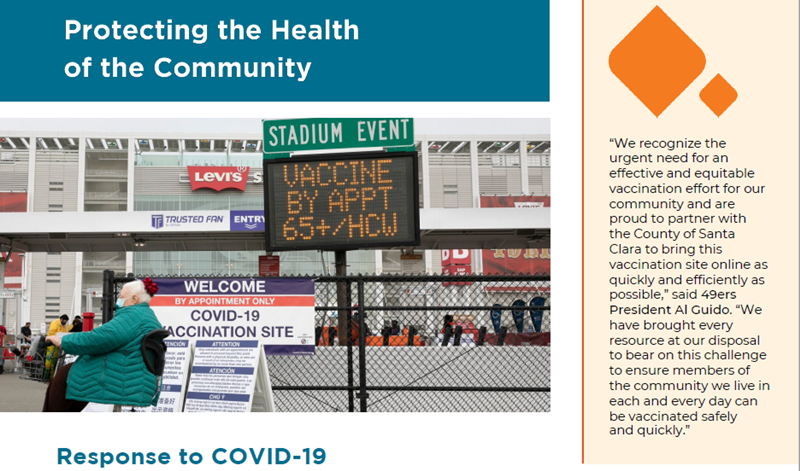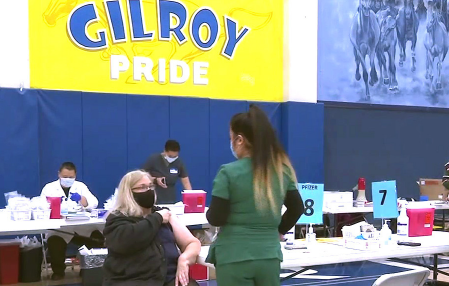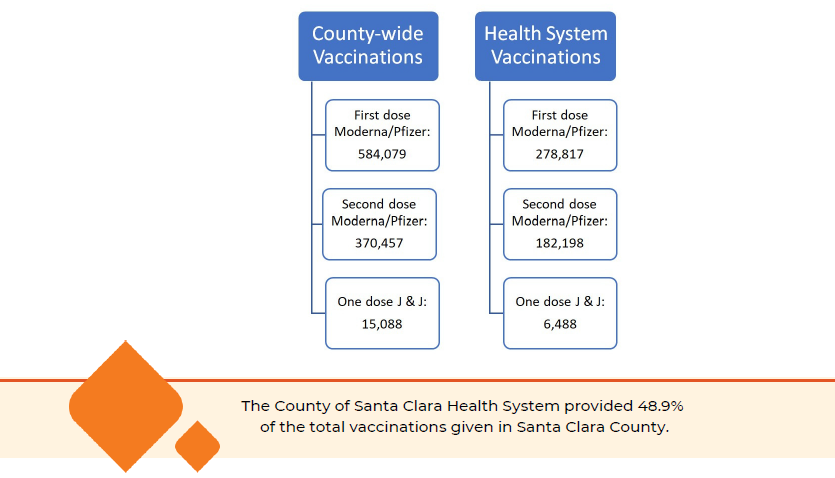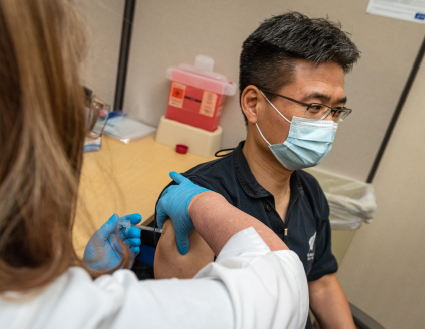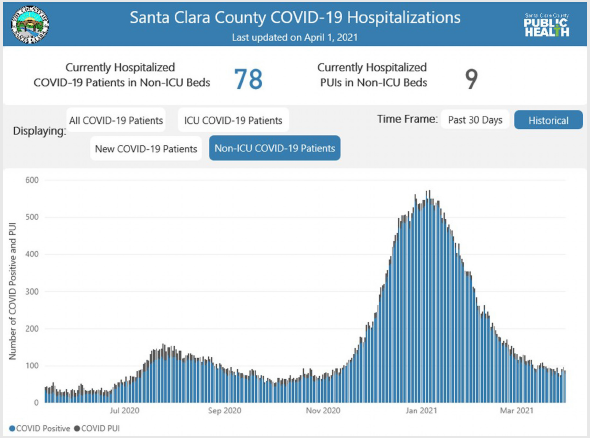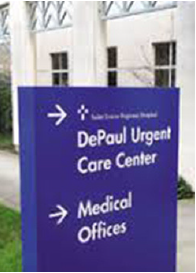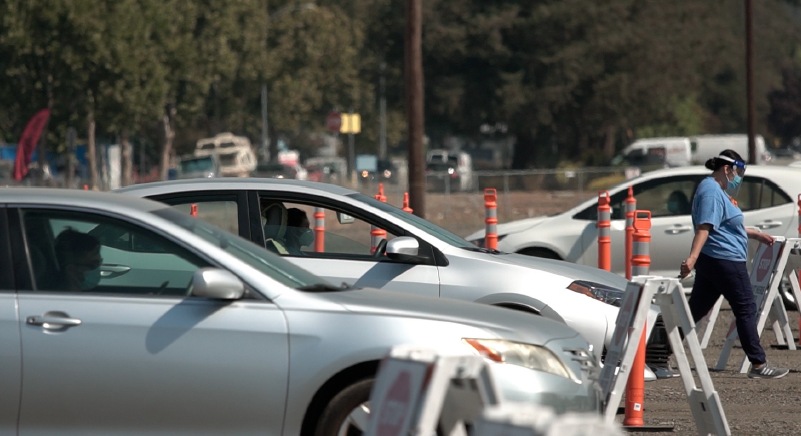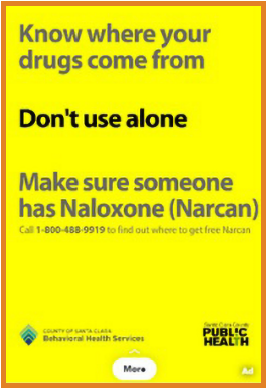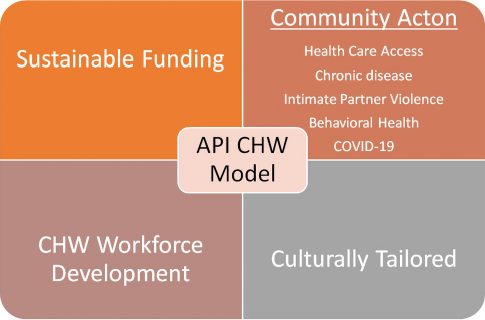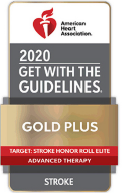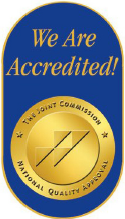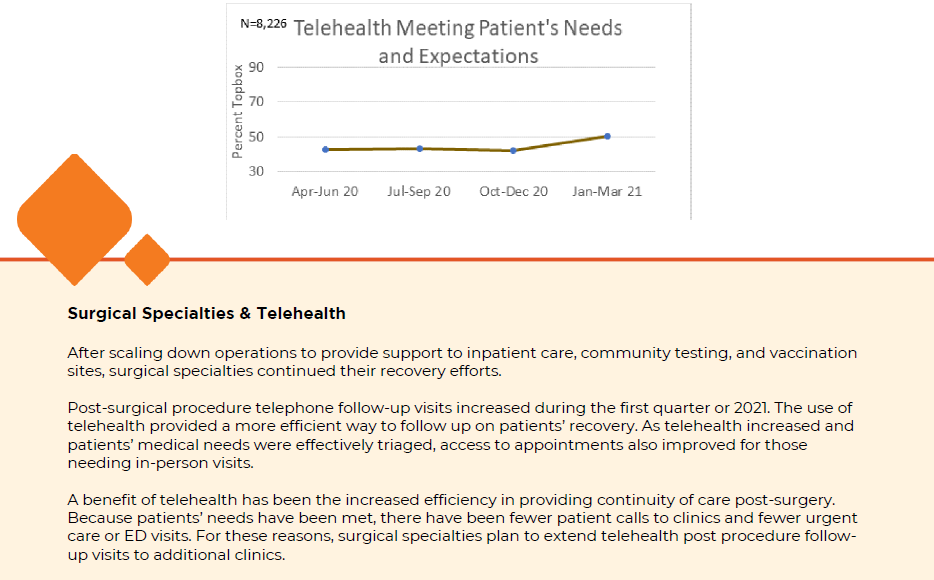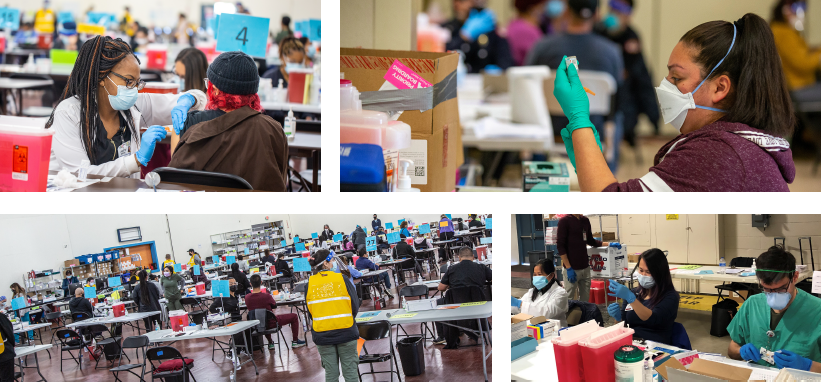Quarterly Report - January to March 2021
For nearly a year, we have seen our world shift, change, and adapt as we continued to deal with the demands of the pandemic. The new year brought both a considerable threat – a tremendous surge of COVID-19 cases and hospitalizations – and a new hope – the beginning of vaccination efforts.
Even though the vaccination distribution system was complex and vaccine supply changed weekly, the County of Santa Clara with the Public Health Department and Santa Clara Valley Medical Center Hospitals and Clinics, managed their supplies successfully. The Health System’s efforts resulted in our departments providing half of all vaccines given in Santa Clara County.
The Health System and its departments have effectively adapted to these turbulent times. As our community makes progress towards a new sense of normalcy, we will continue our journey of transformation to reframe the work on hand, reform areas of operations, and realize our potential to provide the best care possible to every community we serve.
Vaccination
In the first quarter of 2021, vaccination efforts were focused on healthcare personnel, long-term care facility residents, county residents age 65 and older and other groups outlined by the CDC and State Department of Public Health.
In February, the San Francisco 49ers and the County of Santa Clara announced the creation of California’s largest vaccination site at Levi’s Stadium. When vaccine supplies match site capacity, this site alone can provide 15,000 vaccinations per day. The Levi’s Stadium site is staffed and operated by Santa Clara Valley Medical Center (SCVMC).
Vaccination
To open Levi’s Stadium and other new vaccination sites, the Santa Clara Valley Medical Center team worked with Emergency Operations Center and Public Health Department vaccination staff on logistics, site development, staffing, and training at each vaccination site. In addition, educational and instructional materials were developed and revised for distribution to those receiving the vaccines.
Regarding its own healthcare workforce, by March 1, 2021, nearly 6,300 SCVMC, O’Connor Hospital, and St. Louise Regional Hospital staff were in the process of being fully vaccinated. And O’Connor Protecting the Health of the Community Hospital hosted a vaccination clinic for community health care workers and those over 75 years of age.
In January, daily vaccination volumes in the county ranged between 4,000 to 5,000 per day on weekdays. As of February 1, 2021, more than 100,000 vaccinations had been provided to the community. By March 31, 2021, the County of Santa Clara had provided 969,623 vaccines to people who live or work in our community.
COVID-19 Data through March 31, 2021 for the County of Santa Clara
COVID-19 cases: 114,683 Total deaths: 1,942
Focus on Vaccine Equity
The Public Health Department, working with SCVMC, rapidly expanded the County’s ability to vaccinate patients and community members in underserved and high-risk areas, with a focus on improving vaccine access for Hispanic/Latino residents and the communities hardest hit in our county.
Santa Clara Valley Medical Center provided COVID-19 vaccinations at locations throughout the county. A new large-scale appointment-only vaccination site opened at Gilroy High School. Additional dropin, community-based mobile vaccination clinics were also opened, including sites in East San José and Gilroy. At these sites no appointments were needed.
In addition to the Gilroy and East San Jose locations, a partnership with Gardner Family Network helped to serve underserved communities. The Gardner effort included providing vaccines at their clinics and the School of Arts and Culture at the Mexican Heritage Plaza. Other outreach efforts included sign-up fairs at central locations like San Ysidro Park in Gilroy, Story Road in San Jose, Cupertino Senior Center, and other key sites throughout the county.
Vaccinating Unhoused Residents
SCVMC’s Valley Homeless Healthcare Program began vaccinations at shelters and motels on March 1, 2021. Community Outreach staff and the Backpack Medicine teams continued to engage patients at encampments and provide vaccine information. The Medical Mobile Unit was used at larger encampment sites to make sure people knew where to go to receive the vaccine.
As of April 1, 2021, VHHP has administered a total of 1,265 vaccinations: 413 first doses, 333 second doses, and 519 one dose vaccines.
Hospital Response
Throughout the pandemic, Santa Clara Valley Medical Center, O’Connor Hospital, and St. Louise Regional Hospital continued to transform and make necessary changes to meet patient, staff, and community needs. In late December 2020, our public hospitals experienced an unprecedented surge of both COVID-19 and non‐COVID-19 patients. This high census, as shown below, continued for the first two weeks of January 2021, before beginning to decline. The situation put a strain on hospital capacity and resources, but with surge planning and exceptional cooperation, assistance, and support between all hospitals in our county, our facilities were able to successfully manage the surge in patients.
During this time our public hospitals adjusted and rescheduled non-emergency procedures to support inpatient needs. Other measures taken to improve flow and capacity included:
- Conducted rapid COVID-19 testing in the Emergency Department to reduce the turnaround time for persons under investigation (PUI) and inform decisions about care.
- Opening surge units for intensive care and medical/surgical level patients to increase hospitals’ capacity.
- Moved patients between the three hospitals if there was overcrowding at one facility.
- Worked with other hospitals in the county to balance patient loads.
- Improving the early discharges process to reduce the time patients stayed in the hospital. Changes like these support transformation efforts and better meet patients’ needs.
Hospital Response
The County of Santa Clara’s DePaul Health Center continued to provide non‐acute level of care to help relieve capacity issues at the three public hospitals. The Center was also opened for referrals from other acute care hospitals within the county. Non-acute patients cared for at this facility included:
- Homeless patients who still needed care such as intermittent infusion of antibiotics.
- Skilled nursing facility (SNF) patients who could not return because of a COVID-19 outbreak in the SNF.
- Other patients from congregate living spaces who needed further care or assistance or were either in quarantine or isolation.
Additionally, the new pediatric clinic at the health center had originally opened for three days a week. It was expanded to five days a week in March 2021.
Valley Connection
Valley Connection is the appointment and advice line for Santa Clara Valley Medical Center Hospitals and Clinics. Valley Connection took on new responsibilities to meet the needs of all residents of our county. A new community testing and vaccination line was established to handle the large volume of pandemic related calls.
Valley Connection became the main point of contact for COVID-19 testing results and vaccine appointments. They also responded to general questions about the pandemic. Physicians and nurses were assigned to provide clinical direction and much needed advice to the public.
Valley Connection provided these services to both patients and all Santa Clara County residents, regardless of their insurance or affiliated medical system. In addition, the County of Santa Clara’s Technology Services and Solutions Department deployed resources to update call distribution systems, and update messages and directives on our interactive voice response system.
The result of this effort was a historic new level of call volumes.
Testing
During the first quarter of 2021, each week nearly 39,000 COVID-19 tests were performed by the County
of Santa Clara. The primary community testing sites staffed by the County of Santa Clara Health System have been:
- Fairgrounds – 7 days a week
- City sites – 5 days a week
- Pop-up testing (2 sites) – 5 days a week
- Mobile testing teams – 4 days a week.
COVID-19 testing also occurred at shelter sites and encampments. SCVMC’s Valley Homeless Healthcare Program testing teams performed 20,373 tests at shelter sites, safe parking sites and large encampments. A total of 278 positive results were found among homeless individuals. March was particularly encouraging for the team. There were zero positive results among unhoused individuals in the entire month.
Ongoing COVID-19 testing of the community, employees and patients is an important public health tool. Testing includes identification of variants that may put the county at increased risk for infections. Public and social media messages continued to emphasize getting tested and wearing a mask, even if you are vaccinated.
Isolation and Quarantine
From the beginning of the pandemic through March 31, 2021, the County’s Isolation and Quarantine Program has helped thousands of people. Over 2,100 individuals were assisted in local motels, and more than 4,100 households at home. The program provided supportive services including over $857,000 in groceries and other necessities, and distributed over $9 million in direct rental and financial assistance.
Serving Vulnerable Communities
The County of Santa Clara Office of Supportive Housing and SCVMC’s Valley Homeless Healthcare Program have teamed up to serve vulnerable people who may need housing or support services. Together they have managed two important programs.
- The Shelter and Hotel Program operated a hotline to place people in shelters and hotels or motels to safely shelter in place and avoid being exposed to COVID-19. Unhoused and housed people who tested positive for COVID-19, or had been exposed to someone who tested positive, were eligible for assistance when they did not have a place to isolate or quarantine.
- The Isolation and Quarantine Program partnered with several local cities to provide support for people who did not have a place to isolate or quarantine. The program delivered groceries, household items, and baby supplies, and identified financial or rental assistance if people were unable to work because they were in isolation or quarantine.
These programs are staffed primarily by County of Santa Clara employees serving as Disaster Services Workers (DSWs). Since April 2020, DSWs have worked to provide essential services to thousands of people in need. More than 5,700 people have been placed in shelters, hotels, or motels, and over 30,000 hotline calls have been received.
Quality and Safety
Santa Clara Valley Medical Center’s Quality and Safety Division has responded to the extraordinary demands of the pandemic. Infection Prevention managers and staff at all County of Santa Clara hospitals have provided leadership and direction for identification, reporting, and management of patients with COVID-19. They also supported staff safety with guidelines on the use of personal protective equipment, and isolation practices and procedures. The team worked closely with physicians, nursing, and hospital leadership to make sure that safety and compliance with regulatory requirements are ensured and that care is timely and appropriate.
The Suicide Prevention Program conducted training in January 2021 with 123 staff and community members in our county. Behavioral Health Services staff and school personnel participated in the Be Sensitive, Be Brave: Suicide Prevention training, and 50 behavioral health clinicians received Suicide 201: Advancing Suicide Prevention and Clinical Management for Diverse Clientele training.
The Suicide Prevention Program also extended a prevention and awareness campaign among Spanish and English-speaking adult males between the ages of 35 and 54. This group has one of the highest rates of suicide in Santa Clara County. The goals of the campaign were to improve knowledge about when and where to seek help for suicidal thoughts, improve attitudes toward seeking help for suicide and to reduce stigma, and increase help-seeking behavior.
Radio spots ran on both Spanish and English stations. Ads also ran on Spotify and digital banner ads were placed on variety of websites that this demographic was likely to visit. Other digital ads were served at selected locations and addresses in the county.
The Behavioral Health Services Department partnered with the Morgan Hill Police Department to establish a Mobile Crisis Response Team (MCRT) in Morgan Hill. MCRT connects individuals suffering from mental health illness to services. A trained police supervisor teams with a mental health clinician to respond to in-progress calls, de-escalate conflicts between patients and law enforcement, provide safe and timely options, and reduce recidivism among high-risk individuals with mental illness and substance abuse challenges. Teams will also work with individuals who have generated multiple police calls due to a mental health illness.
In 2020, deaths from fentanyl overdoses were up 200% in Santa Clara County. To address this public health issue Santa Clara County Behavioral Health Services Department, the Public Health Department, and County of Santa Clara Health System worked on an extension of an anti-opioid campaign. The goal of the campaign was to raise awareness about the risk of overdose and death from drugs that also contain Fentanyl. The campaign focused on educating people about harm reduction strategies to prevent and protect themselves and others from overdoses. This includes knowing the source of their drugs, not using alone, and having access to Narcan, a medication used for the emergency treatment of an opioid overdose.
The audience was 14-30-year-old individuals living in Santa Clara County. Digital ads, Instagram and Snapchat were the primary channels for communications. These ads were seen an impressive 4,211,391 times through the various ad channels and placements, with Snapchat accounting for over 2 million of these impressions.
In January, the Emergency Medical System (EMS) Agency began having medics in the field advance their documentation of cases of suspected sexual abuse. This included improvements in the assessment for signs and symptoms of abuse, neglect, or domestic violence. In addition, the EMS Agency is finalizing the assault, abuse, or domestic violence policy and protocols to provide standards for identification of suspected abuse and the requirements for prehospital personnel when incidents of child, elder, dependent adult, or domestic violence is reported or reasonably suspected. All EMS medics have been trained on the protocols and the new policy will include training and resources for all field personnel.
Asian Pacific Islander (API) Health Assessment Update was conducted to assist the County of Santa Clara Health System in meeting Asian Pacific Islander residents’ health needs. The assessment revealed that cancer and heart disease were the top two leading causes of death among Asian and Pacific Islanders. Other areas of concern identified were poverty in the senior population, tuberculosis, liver cancer, and mental health.
As part of the assessment, the Public Health Department partnered with Asian Americans for Community Involvement (AACI) to facilitate focus groups to identify service gaps, priority areas, and prioritize strategies for each of the seven API subgroups: Asian Indian, Chinese, Filipino, Korean, Japanese, Vietnamese, and Pacific Islanders. Following the focus groups, Public Health performed further community engagement with over 60 community partners at a community meeting where they identified five key priorities:
- Community health worker program
- Culturally appropriate outreach services
- Mental health
- Seniors
- Intimate partner violence
Community stakeholders identified the Community Health Worker (CHW) model as a strategy to establish a workforce of trained, trusted community partners to address the health disparities, obstacles and system gaps identified in the API sub-populations.
In March 2021, the Board of Supervisors approved a $400,000 agreement with AACI to provide the implementation and infrastructure support for the API CHW program through March 2022
Hospital Activities
- Santa Clara Valley Medical Center Hospitals and Clinics achieved Stage 7 certification from internationally recognized Healthcare Information and Management Systems Society (HIMSS). They were recognized for using electronic medical records and data to improve patient care and outcomes. The HIMSS Stage 7 status is the highest level an organization can achieve. Santa Clara Valley Medical Center first achieved Stage 7 in 2017. With O’Connor Hospital and St. Louise Regional Medical Center, all three hospitals have Stage 7 certification through 2023.
- St. Louise Regional Hospital achieved the “Get with the Guidelines” Gold Plus Target Stroke Honor Roll Elite Award for 2020. From the American Stroke Association/American Heart Association this award indicates the organization met the Primary Stroke Center Certification requirements. The hospital also achieved the California Honor Roll for Opioid Care and Maternal Care.
- Santa Clara Valley Medical Center is one of the 32 hospitals in California that achieved high performance standards in both maternity and opioid care. In addition, Santa Clara Valley Medical Center achieved superior performance for opioid management and self-assessment. These recognitions came from Cal Hospital Compare.
- The Joint Commission granted accreditation to Santa Clara Valley Medical Center Hospitals and Clinics laboratories. Laboratory services are indispensable in providing patient-centered care and in improving health outcomes and overall public health. Clinical laboratory services are one of the most cost effective, least invasive sources of objective information used in clinical decision-making.
- Infusion Clinic services at O’Connor Hospitals expanded, treating 8‐12 patients a day, and opened for referrals to provide monoclonal antibody therapy approved for use in select COVID-19 patients with mild to moderate disease.
- The Bariatric Surgery Program opened to offer comprehensive services including surgery to patients of the Health System.
Telehealth
During the pandemic, many patients were offered telehealth visits as an alternative to traditional in person office visits. Questions have been added to the patient experience survey to assess satisfaction with alternative methods of contact with their providers and to assess the impact of these services. The Health System hopes to continue telehealth services for patients and clients.
Journey of Transformation
The work of the County of Santa Clara Health System and its departments contributes to the health and well-being of our staff, patients, clients, and community. We continue to focus on the challenges and changes in the delivery of care, services, treatments, and information, to make grow, improve and realize success. We continue our efforts to transform to be more effective and efficient and enhance the quality of care and services we provide. Please continue to follow us on this journey.
About Us
The County of Santa Clara Health System is Santa Clara County’s public healthcare safety net and provides comprehensive care, services, and programs to the residents of our county. It includes the Behavioral Health Services Department, Public Health Department, Santa Clara Valley Medical Center Hospitals and Clinics, Emergency Medical Services Agency, Custody Health Department, and Valley Health Plan.
Follow us on
Facebook @cschealthsystem
YouTube @County of Santa Clara Health System
Twitter @cschealthsystem
Health System web page: https://www.sccgov.org/sites/hhs/

